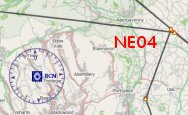| Briefing | 1st January 2018 |
| Overview | This is my first event as the newly appointed Events Manager, so I've decided to make this month's event a navigation exercise suitable for new members of the Club as well as the old hands who think they know it all! The departure airport is our Club base, Gloucestershire (EGBJ) and arrival airport is Swansea (EGFH), an airfield we haven't visited during an offical Club event since 2007. |
| Start Time and Place | This event may be flown on any day in January. Being a navigation exercise, it may be best to fly it on your own, in order to concentrate on the all-important headings, altitude and location (visual fixes), but it is up to you. |
| Route | Take off from EGBJ and if possible do an overhead dearture(more info in Training Exercise 4a, as it will help you on the 1st leg.
NE10 is the final waypoint, and with a bit of luck (and low winds) you should now be within range of the SWN NDB(320.5KHz). Proceed to EGFH and land. |
| Flight Planning | "Dead Reckoning" is the art of arriving where you intented to by flying a fixed heading for a precise period of time. You need to calculate the times from your planned airspeed, any heading correction due to the forecast wind and the distances given above. There is no pre-prepared Plan-G file of the route, BUT please avoid using Plan-G to navigate part of the fun will be to navigate by Dead Reckoning, or by identifying ground features. (N.B. if flying in company don't blindly follow your companion you might infringe a danger zone or controlled airspace by doing that!). Your VATSIM flight plan should show: - |
| Notes | 1. NE is short for Navigation Exercise, NE01 is Navigation Exercise Waypoint 01 and so forth. |
| Weather | Before starting we will check the weather.
Please use VATSIM weather if at all possible for greater realism, and a more interesting challenge. Note that the Maximum Elevation Figure (MEF) en route, is around 3000ft AMSL. |
| ATC | At the time of publishing this event, ATC has not been confirmed. However, you may find that Gloucester Approach and/or Gloucester Tower is manned, plus Swansea Radio. |
| Radio Discipline | Take care not to let our Teamspeak chat cut across ATC. Stop any conversation immediately the R/T comes alive, then continue if "he wasn't talking to us". This is difficult because when transmitting on Teamspeak you can't hear the R/T. So be brief on Teamspeak, and be aware that ATC might be trying to get through. If anyone hears an R/T message which seems to be being ignored, just say "ATC is calling G-CIXN" if you have identified the callsign, or "ATC is calling us" which is a cue for everyone to be quiet on Teamspeak until ATC call again (which they will). Remember too that if asked to "Stand By" by ATC, you do not reply - not even "Roger", but simply wait until you are called again. Remember also that there are several different ATC frequencies in use, and you may not be able to hear when communications are taking place. Make sure you have set and know how to use a Teamspeak mute switch. |
| Acknowledgements | Event concept: Tomas Linnet Briefing: Tomas Linnet |
